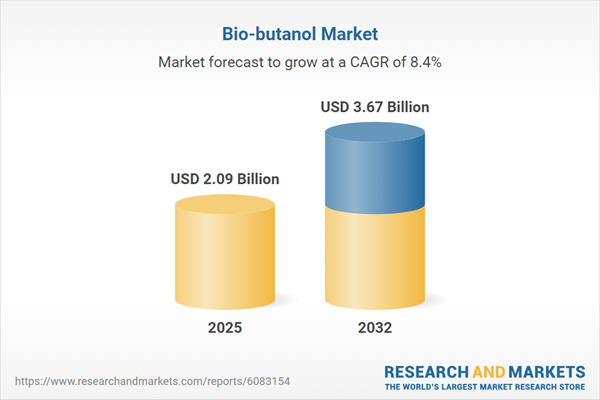Speak directly to the analyst to clarify any post sales queries you may have.
Bio-butanol is rapidly emerging as a preferred renewable chemical across fuel and industrial sectors, offering senior executives practical pathways to advance sustainability and operational imperatives simultaneously. This report focuses on actionable strategies for decision-makers evaluating bio-butanol’s role in current and future business portfolios.
Market Snapshot: Bio-Butanol Market Size and Growth
The bio-butanol market achieved a valuation of USD 1.93 billion in 2024 and is forecast to grow to USD 2.09 billion by 2025. With a projected compound annual growth rate (CAGR) of 8.36%, the market is set to reach USD 3.67 billion by 2032. Growth is supported by significant advancements in processing technologies, a regulatory landscape increasingly focused on reducing emissions, and diverse adoption across multiple industries such as transportation, chemicals, and specialty manufacturing. These drivers are shaping a competitive marketplace where senior leaders are emphasizing agile operational strategies to optimize compliance and efficiency outcomes.
Scope & Segmentation
- Feedstock Types: The sector draws on agricultural residues like corn stover, rice straw, and wheat straw, as well as bagasse, corn starch, sugarcane juice, syngas, and wood chips. These feedstocks are critical in determining cost structure and enabling continuous supply, which is central to risk mitigation and long-term planning.
- End-Use Industries: Key demand drivers include biofuels (covering aviation, gasoline, marine), coatings, pharmaceuticals, plasticizers, and solvents. These segments have distinct requirements for product performance and purity, influencing commercial approaches.
- Technologies: Production methods range from ABE fermentation with Clostridium strains to advanced platforms using genetically engineered microorganisms, catalytic conversion processes, and emerging enzymatic techniques. Selection of technology directly impacts efficiency and the flexibility to utilize various feedstock sources.
- Purity Grades: Producers offer chemical, fuel, and pharmaceutical grades tailored to specialized downstream uses, enabling companies to address varying regulatory and quality benchmarks.
- Distribution Channels: Bio-butanol is delivered via direct sales, distributor partnerships, and digital e-commerce channels. This diversification enhances both reach and adaptability in addressing evolving market requirements.
- Applications: Uses span as chemical feedstock (for butadiene, esters, plastics), fuel additives for transportation and marine industries, and as solvents supporting a broad spectrum of manufacturing and formulation activities.
- Regional Coverage: The market covers the Americas, Europe, Middle East and Africa, and Asia-Pacific. Regional variations in feedstock availability and differences in policy frameworks shape the pace and nature of local market growth.
- Key Companies: Major industry figures include Gevo, Inc., Butamax Advanced Biofuels LLC, Green Biologics Ltd., Cobalt Technologies, Inc., Tereos SA, Eastman Chemical Company, BASF SE, ButylFuel LLC, BioEnergy International AG, and Ingevity Corporation, all of whom actively influence both technology and market direction.
Key Takeaways for Senior Decision-Makers
- Bio-butanol’s performance characteristics, such as high energy density and lower vapor pressure, make it suitable for demanding use cases where legacy options present environmental or technical challenges.
- Innovations in fermentation and catalytic processes are increasing yield efficiency and broadening the pool of economically viable feedstocks, which supports cost optimization and risk management.
- Evolving regulatory pressures are accelerating adoption, particularly in transportation fuels and specialty chemicals, compelling organizations to adapt supply and compliance frameworks proactively.
- Partnerships from feedstock suppliers through to technology licensors are strengthening supply chain resilience, reducing commercialization barriers, and supporting scale-up efforts.
- Market competition is intensifying, which encourages companies to deepen integration and develop new collaborations to enhance market presence and resilience amid evolving policy landscapes.
- Downstream customers, especially in sectors such as specialty chemicals and fuels, increasingly prioritize lifecycle emissions and traceability, pushing suppliers to deliver higher-purity, transparent product offerings.
Assessing Tariff Impact on Bio-Butanol Market Dynamics
Recent shifts in United States tariff policy have reconfigured global trade flows and influenced pricing for bio-butanol. Exporters affected by these tariffs are redirecting shipments to other regions, while domestic producers are benefiting from short-term market advantages. Multinational firms are mitigating risk through financial hedging, contract renegotiation, and targeted requests for regulatory exemptions on specific feedstocks. Purchasers in critical sectors—such as fuels, solvents, and pharmaceuticals—now face heightened supplier negotiation complexity. These market changes underscore the importance of adaptive procurement strategies and supply chains that balance flexibility with reduced risk exposure as global trade and policy frameworks evolve.
Research Methodology & Data Sources
This analysis is grounded in structured interviews with industry specialists, comprehensive review of peer-reviewed literature, assessments of regulatory databases, and patent evaluations. Insight validation follows a triangulation approach, incorporating plant-level production data, trade flow analysis, and external expert panels for assurance of accuracy and risk evaluation.
Why This Report Matters
- Supports strategic alignment of bio-butanol initiatives with evolving regulatory standards and technological trends in key regional markets.
- Enables executive teams to navigate competitive forces by informing resilient supply chain design and effective technology integration in volatile market environments.
- Facilitates proactive positioning as sustainability benchmarks and buyer requirements evolve, ensuring ongoing relevance and growth potential.
Conclusion
The bio-butanol market provides significant potential for innovation, enhanced supply chain management, and strategic growth. Senior leaders will gain targeted insights to inform investment and adaptation as global energy and chemicals sectors transition.
Table of Contents
3. Executive Summary
4. Market Overview
7. Cumulative Impact of Artificial Intelligence 2025
Companies Mentioned
The companies profiled in this Bio-butanol market report include:- Gevo, Inc.
- Butamax Advanced Biofuels LLC
- Green Biologics Ltd.
- Cobalt Technologies, Inc.
- Tereos SA
- Eastman Chemical Company
- BASF SE
- ButylFuel LLC
- BioEnergy International AG
- Ingevity Corporation
Table Information
| Report Attribute | Details |
|---|---|
| No. of Pages | 187 |
| Published | October 2025 |
| Forecast Period | 2025 - 2032 |
| Estimated Market Value ( USD | $ 2.09 Billion |
| Forecasted Market Value ( USD | $ 3.67 Billion |
| Compound Annual Growth Rate | 8.3% |
| Regions Covered | Global |
| No. of Companies Mentioned | 11 |









